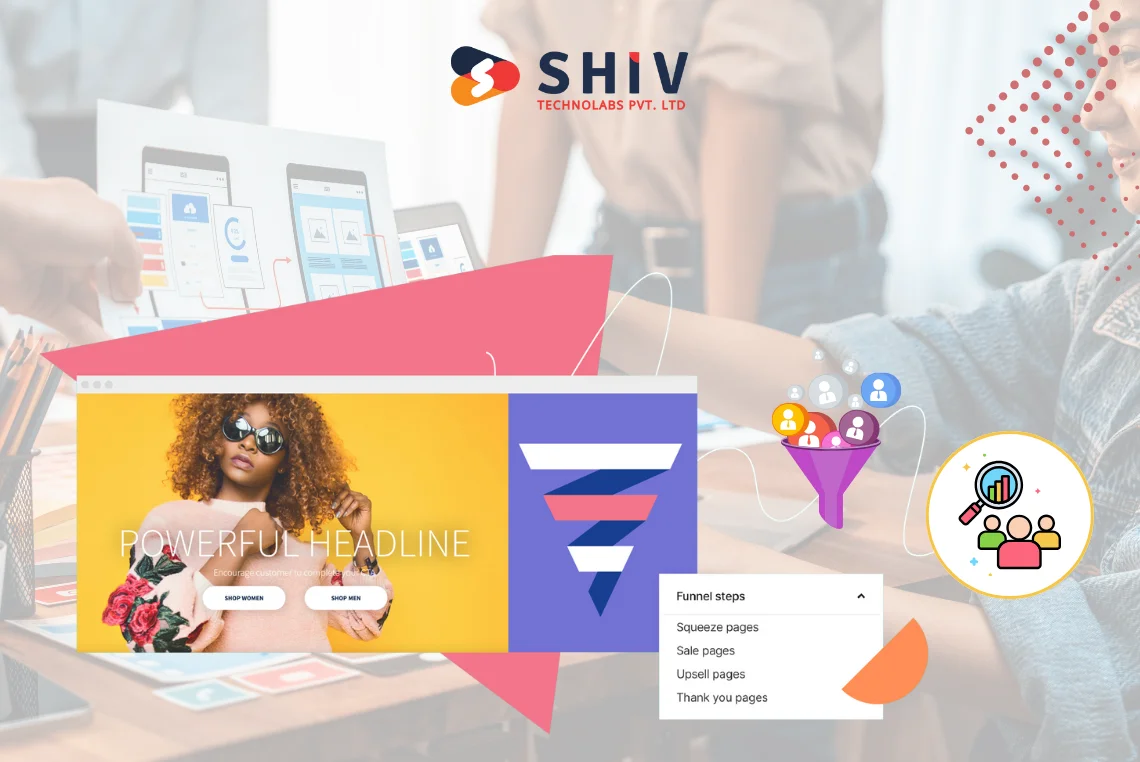Table of Contents
Companies investing in digital upgrades in 2026 are starting to view front-end development as more than pretty buttons and colors; it’s actually become a business move to win customer attention at first glimpse. Aesthetic appeal combined with solid functionality matters a lot in enterprise applications, where usability directly impacts team productivity and conversion rates.
A strong front end keeps users engaged, speeds up work, and improves performance; that’s exactly why providing custom front-end development for enterprise applications matters so much for B2B platforms. Research shows that investing $1 in UX returns roughly $100, a 9,900% ROI.
This article will walk through what front-end development for B2B platforms is, which main features big companies actually need, a reliable way to build it, and an honest cost breakdown to help you plan your budget.
What Is Front-End Development for B2B Platforms?
Front-end development for B2B platforms means building the parts of business software that users actually touch the screens they look at, the buttons they press, the tools they use shaped by how companies operate, how teams function, and how they handle complex information.
Front ends in B2C are typically aimed at establishing quick, emotion-driven routes to normal people, whereas B2B front ends need to be oriented towards getting work done quickly, controlling who can see what, operating with data, and ensuring various job classes cooperate with each other.
- With B2B, you’re building for groups of people, various job types, bigger connections and processes that take longer.
- With B2C, you’re usually building for one person at a time, keeping things simple, driving sales, and getting quick results.
Here’s a comparison:
| Aspect | B2B Front-End | B2C Front-End |
|---|---|---|
| Focus | Efficiency & collaboration | Visual appeal & sales |
| Users | Teams, enterprises | Individual buyers |
| Key Features | Role-based dashboards, workflow tools | Simple checkout, consumer UI |
When you’re dealing with enterprise front-end development, what you’re trying to do shifts from “looks nice” to “actually works”, aligning with the business’s needs, connecting with backend systems, letting different roles see different things, and helping teams finish their work. Bringing in a specialist Front-End Development Company makes sure you connect what users do with what the business wants.
What Are the Core Features of Front-End Development for B2B Platforms?

A B2B application needs certain things on the front end to work right. Here are the ones you’ll pretty much always need.
Scalable Architecture for Enterprise Growth
You want your front end built in pieces so when you get more data, more users, or add new parts, the interface can grow without starting over from scratch. Building in blocks, keeping things separate, and making UI components you can reuse later help you grow later and make fixing things easier.
Advanced Authentication and User Management
Business settings usually have many different roles (people who run things, people who manage things, regular users, external partners), and each needs to see different dashboards or do different things. Keeping things locked down matters – things like OAuth, SSO, MFA and the front end has to show the right screens and information for each person. Getting user management right sits at the heart of enterprise front-end development.
Real-Time Data Interaction
Today’s front ends don’t just display static pages; they show information that updates in real time. Dashboards, number panels, and status updates all need live or almost-live interaction. Showing data in graphs, tables, and alerts, this helps people make choices and get more done.
Integration with Back-End Systems
Business front ends hardly ever stand alone. They pull information from ERP, CRM, inventory systems, or number-crunching platforms. If your use case involves web apps and store flows, our Web Development Services and eCommerce Development pages outline typical integration paths.
Performance and Accessibility
People want interfaces that move fast, respond well, and everyone can use. Front ends need layouts that adapt to different devices (computers, tablets, phones), screens that load efficiently, pages that load quickly, and rules that help people with disabilities use the system (e.g., WCAG). How fast things work in business applications changes how much people get done.
Optional Features (may vary by platform):
- Multilingual dashboards
- Interactive charts
- Permission layers
- Custom UI components
When considering custom front-end development for enterprise applications, these features should be included in your plans.
What Is the Proven Process for Front-End Development in B2B Platforms?
Creating a good enterprise front-end isn’t guesswork—it follows clear steps. Here’s what a reliable workflow looks like.
1. Requirement Analysis and Research
Start by determining who uses your system, what they do, the relationship you have to maintain, and the processes in place. Converse with teams, meet with decision-makers, extract positions and authorization, and codify what must operate and how it must operate.
2. Wireframing and UI Design
After you know what’s needed, create pictures of what things will look like: basic layouts, detailed designs and user paths made for your business audience. What you’re after is ensuring the interface aligns with real work processes rather than generic shopping experiences.
3. Technology Stack Selection
Picking the right tools matters for growth and speed. You could pick:
| Framework | Use Case | Key Benefit |
|---|---|---|
| React | Dynamic dashboards | Reusable components, wide ecosystem |
| Angular | Enterprise apps | Two-way binding, built-in structure |
| Vue | Lightweight tools | Simplicity, gentle learning curve |
Getting the right framework means your front end will run well, grow and stay fixable.
4. Development and API Integration
As you develop UI bits, integrate with APIs (to ERP/CRM/data), design the flow of information, handle errors and interact with live data. Front-end professionals and programmers are employed simultaneously to ensure data flows in the right direction.
5. Testing and Quality Assurance
Check things on different browsers, devices, user types and data situations. Testing individual pieces, testing how things work together, checking speed, and making sure everyone can use it—all this confirms that your front-end meets business standards.
6. Deployment
At the end, you launch your front end—tuned up, locked down, responsive—and keep watching numbers like how fast things load, how much people use it, how many errors pop up and how many adopt it. Now, your front end should affect how well the business runs and how happy users are.
Working with an experienced Front-End Development Company makes sense because business workflows, connections, and user roles get complicated—they need people who really know this stuff.
How Much Does It Cost to Build a Custom Front-End for B2B Platforms?

Figuring out the cost depends on its size, what it connects to, the number of user types, the number of screens, and how fast it needs to run. For a typical enterprise front-end project:
- Small-scale MVP (basic dashboard, few integrations): $30,000-50,000
- Mid-scale (multiple dashboards, role-management, moderate integrations): $70,000-120,000
- Large-scale (many modules, heavy real-time data, complex API ecosystem): USD 200,000+
Costs cover design, building, testing, launching and keeping things running. Working with a specialist company like Shiv Technolabs delivers good value while maintaining business standards.
Common Mistakes To Avoid in New Front-End B2B Projects
Messing up is easy. Here’s what to watch out for:
- Building for how consumers like things to look, rather than how businesses need to work.
- Not caring about speed and access for everyone from the start.
- Picking tools without thinking about growing later or what your team knows.
- Thinking API/connection stuff and backend ties will be easier than they are.
- Skipping research on user roles; thinking everyone’s the same.
- Dodging these problems helps make sure your money spent on front-end development for B2B platforms actually pays off.
Conclusion
Front-end development for B2B platforms isn’t something you do on the side – it decides how teams work, how data shows up, how jobs get finished, and how much people accomplish. From picking the right audience and features to sticking to a solid process and planning costs correctly, every part counts.
Shiv Technolabs is the best Front-End Development Company that helps businesses develop top-class enterprise applications that win customer attention with aesthetic and functionality. We have a dedicated team of developers ready to assist you with basic to complex front-end development services. Our team follows the result-driven front-end development process that takes you every step closer to modern development, leaving no room for poor experience.
If you’re serious about creating business-grade front-ends that grow, run fast and keep users engaged, begin with Shiv Technolabs. Reach out today to see how we can change your B2B platform with custom front-end development and strong enterprise UX.
FAQs
Q1. What technologies are best for B2B front-end development?
React, Angular and Vue each bring real benefits in business settings. React works great with changing dashboards and pieces you can reuse. Angular fits big business apps with structure already there. Vue works well for simpler tools where you need things done fast. A specialist service provider can help you pick the one that matches your needs.
Q2. How long does a custom front-end project take?
Usually somewhere between 8 weeks to 6 months, depending on how complicated it is. An MVP with not many screens and connections might take 2-3 months. Bigger projects with lots of roles, dashboards, and live data can take 4-6 months or longer.
Q3. What security measures are critical for B2B front-end systems?
Security features such as SSL encryption over the Internet, secure session handling, role-based access control (RBAC), two-factor authentication (2FA), and secure API communication are important. Ensuring your front-end aligns with the business’s backend security and compliance rules is crucial.
Q4. Can traditional B2B systems be upgraded with modern front-end frameworks?
Yes definitely. Lots of companies keep their back-end logic but rebuild the front-end with newer frameworks. A front-end built in pieces lets you redo the user interface without redoing the whole back-end. It’s a smart way to get modern UX without breaking the bank.
Q5. How do front-end services improve enterprise ROI?
By making user interfaces that ease mental strain, speed up workflows and help teams do their jobs better, front-end services increase how much gets done and how many people use them. That leads to fewer mistakes, less time teaching people, faster choices and better use of business systems overall.






















